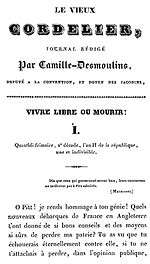Le Vieux Cordelier
 First issue of Le Vieux Cordelier | |
| Type | Daily newspaper |
|---|---|
| Format | Broadsheet |
| Editor | Camille Desmoulins |
| Founded | 5 December 1793 |
| Political alignment |
Dantonism; Moderatism |
| Language | French |
| Ceased publication | 3 February 1794 |
| Headquarters | Paris, French Republic |
| Circulation | unknown |
Le Vieux Cordelier was a journal published in France between 5 December 1793 and 3 February 1794. Its radical criticism of ultra-revolutionary fervor and repression in France during the Reign of Terror contributed significantly to the downfall and execution of the Dantonists, among whom its author, the journalist Camille Desmoulins, numbered. It comprised seven numbers, of which six appeared; the seventh remained unpublished for some forty years.[1]
The title of the Vieux Cordelier ("Old Cordelier") refers to the Cordeliers Club, an influential revolutionary society that, from its relatively moderate origins under Danton, had come to be associated with ultra-revolutionary factions – principally the followers of journalist Jacques René Hébert. Desmoulins sought to ally his journal's arguments with the less extreme politics of the earlier, "old" Cordeliers, while simultaneously repudiating the violent, anti-religious Hébertists. In this goal, Desmoulins was supported by Maximilien Robespierre, who viewed the Vieux Cordelier's attacks on the Hébertists as an effective means of reducing the faction's power and popularity. However, later numbers of the journal introduced criticisms of the Revolutionary Tribunal, the Committee of Public Safety, and Robespierre himself.
The third number of the Vieux Cordelier, appearing 25 Frimaire (15 December 1793), purported to quote without comment passages from the Annals of the Roman historian Tacitus concerning the oppressive reign of the emperor Tiberius. While more likely drawn from the Discourses on Tacitus published in 1737 by Thomas Gordon,[2] these terse portraits - describing a civilization turned sick by fear and brutality - were effective in drawing a powerful parallel between Rome under Tiberius and France during the Terror.
The fourth number, published 30 Frimaire (20 December 1793), argued against the Law of Suspects, saying, "...in the Declaration of Rights there is no house of suspicion... there are no suspected persons, only those convicted of crimes fixed by the law."[3] It also appealed for a "Committee of Clemency" to counter the excesses of the Committee of Public Safety and Committee of General Security. So controversial were these views that Desmoulins was expelled from the Cordeliers Club and denounced at the Jacobin Club. Robespierre, hoping to present his friend "as an unthinking child who had fallen into bad company," recommended that the offending numbers of the journal be publicly burnt as an alternative to expelling Desmoulins from the Jacobins.[4]
In the fifth number, which appeared 16 Nivôse (5 January 1794) though dated 5 Nivôse (25 December 1793), Desmoulins addressed himself in a "justificatory discourse" to the Jacobins,[5] maintaining his calls for an end to the Terror. Shortly after this issue appeared, on 21 Nivôse (10 January), Desmoulins was expelled from the Jacobin Club.[6]
The sixth number, though dated 10 Nivôse (30 December 1793), was further delayed due to the political concerns of its publisher[1] and did not appear until 15 Pluviôse (3 February 1794).[7] Though Desmoulins had rephrased his demands for a Committee of Clemency and called instead for a "Committee of Justice," and turned his attacks again against the politically acceptable target of Hébert, his criticism of the Terror continued.
The seventh number, written in late March, did not appear in Desmoulins' lifetime; early in the morning of 31 March, he was arrested on a warrant issued by the Revolutionary Tribunal. With Danton, he was tried on charges of counter-revolutionary conspiracy and, on 5 April 1794, was executed by guillotine.
References
- Claretie, Jules. Camille Desmoulins and His Wife: Passages from the History of the Dantonists. London: Smith, Elder, & Co., 1876.
- Hammersley, Rachel. French Revolutionaries and English Republicans: The Cordeliers Club 1790-1794. Rochester: Boydell & Brewer Inc., 2005.
- Methley, Violet. Camille Desmoulins: A Biography. New York: E.P. Dutton & Co., 1915.
- Scurr, Ruth. Fatal Purity: Robespierre and the French Revolution. New York: Owl Books, 2006.
- Weber, Caroline. Terror and Its Discontents: Suspect Words in Revolutionary France. Minneapolis: University of Minnesota Press, 2003.
Notes
External links
- Le Vieux Cordelier online in Gallica, the digital library of the BnF.